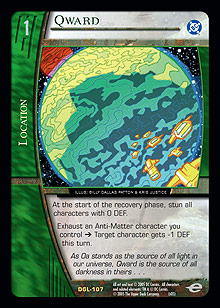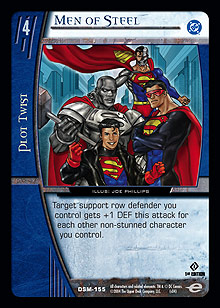When the Green Lantern Corps set came out, I remember opening a card called Qward. It was one of those cards that stood out because it didn’t really seem to fit in on its team. Anti-Matter seemed to focus on aggression from the concealed area with cards like Anti-Green Lantern, Xallarap, Slipstream, and Johnny Quick, as well as the ability to move its characters and the opponents’ characters in and out of the hidden area. Qward and Kiman were the only cards that interacted with characters that had 0 DEF.
I looked at Qward for a while and thought about cards that reduced DEF. No Man Escapes the Manhunters and Yellow Impurity both only gave penalties to DEF while a character was defending. The only card that would really work well with Qward was Kryptonite. That certainly wasn’t enough to support a deck. Anti-Matter had Shadow Creatures to try to abuse Qward with character quantity, but that certainly didn’t seem to be worth the effort. The average 3-drop at the time had 4 DEF, and using four characters to stun a 3-drop after it attacked your unprotected skull seemed horrible. I said to myself, “Nah, that’ll never work,” and several copies of Qward found themselves in the dusty, unused section of my rare binder.
When Pro Circuit Indy 2005 came around, the Green Lantern / Emerald Enemies deck was obviously the deck to beat. The power of Dr. Light, Master of Holograms was immediately apparent, and the GLEE deck was the deck most suited to take advantage of him. At the end of the day, 85% of the decks at the tournament had four copies of Dr. Light. Testing for the PC necessarily started with GLEE and Dr. Light. As a result, Qward—along with a number of other “that’ll never work” decks—never actually got built, and what little non–Dr. Light testing time I got in was spent on the oh-so-close but ultimately tier 2 Manhunters deck.
This was a grave mistake.
As this was a couple of PCs before the Donkey Club really got rolling, the former Team Realmworx, with such players as Ryan Jones, Patrick Yapjoco, and Dave Spears, played a Qward deck. And they won money with it. They weren’t the only ones with the idea to run Qward, but in most cases, teams switched to Qward on the advice of a leak from Realmworx about what they were playing. Twenty-seven people played the deck, but only Spears was able to crack the Top 8. His list:
Dave Spears
Qward
PC: Indy 2005, Top 8
Characters
 19 Shadow Creatures
19 Shadow Creatures
1 Anti-Monitor
1 Krona
1 Two-Face, Split Personality
1 Evil Star
2 Element Man
1 Fiero
1 Malvolio
3 Kiman
1 Kreon
1 Qwardian Watchdog
1 Sinestro, Green Lantern of Korugar
Plot Twists
3 Helping Hand
4 The Ring Has Chosen
4 Men of Steel
3 Emerald Dawn
Locations
4 Qward
4 Sector 2814
4 Birthing Chamber
2 Anti-Matter Cannon
The general idea for this deck was to play as many Shadow Creatures as possible on turns 1 through 3, preferably at least four of them. Nineteen Shadow Creatures meant that on average, you would have drawn four of them by turn 3, which would put your Birthing Chamber online. Each Shadow Creature allows you to shrink your opponent’s smaller characters to death with Qward and also gain scads of endurance with the near-forgotten Sector 2814. (As an aside, Sector 2814 has the distinction of being the largest location represented by a location card in the entire game of Vs. System.)
On turn 4, Kiman came out to play. Against the GLEE deck, Kiman plus five or so Shadow Creatures plus a Qward usually equaled three stunned characters on the opponent’s side of the board without the Qward deck even having to make an attack. Between Kiman and Qward, it became very hard for the typical GLEE deck to maintain its large board presence. Failing a Kiman, the deck also sported a copy of Malvolio, whose 10 DEF soaked up huge amounts of damage from opponents who had to commit their entire teams to stunning him. Fiero served much the same purpose with his 9 DEF.
Element Man was the play of choice on turn 5. When the deck needed to throw a bunch of characters into play to get in the way of a few attacks, Element Man did the throwing. As a bonus, he replaced several of your resources, typically getting you several usable resources. His 10 DEF is also above average for his cost, so he could soak even more damage if you needed him to.
Once the Shadow Creatures were out in the visible area, Sinestro, Green Lantern of Korugar was amazingly annoying. If you decided to keep your Shadow Creatures in the shadows, however, Evil Star was an absolute monster. Because the deck was playing a hidden army, it typically had six or eight characters in play by turn 6, and Evil Star would just blow away the opponent’s best character. After that, Two-Face, Split Personality; Krona; and Anti-Monitor were just there to clean up.
 Four copies of Men of Steel and three of Helping Hand were also reasons this deck matched up so well against GLEE. The typical turn 5 situation involved a single visible character and five or so Shadow Creatures for the Qward deck staring down the GLEE deck’s entire army. With a couple copies of Men of Steel or Helping Hand, the Qward deck could easily either stonewall an attack or force the opponent to send so many characters into the visible character to ensure the stun that the opponent wouldn’t have enough gas left for the kill. Between the endurance saved by your characters’ naturally high DEF and these plot twists, and the endurance gained from Sector 2814, your opponent would have an extremely hard time dealing enough damage to win before the 7-drops started to fall.
Four copies of Men of Steel and three of Helping Hand were also reasons this deck matched up so well against GLEE. The typical turn 5 situation involved a single visible character and five or so Shadow Creatures for the Qward deck staring down the GLEE deck’s entire army. With a couple copies of Men of Steel or Helping Hand, the Qward deck could easily either stonewall an attack or force the opponent to send so many characters into the visible character to ensure the stun that the opponent wouldn’t have enough gas left for the kill. Between the endurance saved by your characters’ naturally high DEF and these plot twists, and the endurance gained from Sector 2814, your opponent would have an extremely hard time dealing enough damage to win before the 7-drops started to fall.
Dave Spears finished Day 1 of the PC with a 9-3 record, dispatching GLEE deck after GLEE deck on his way to the top. He found his nemesis, Rot Lop Fan, waiting in the quarterfinals in the hands of Rob Dougherty, who took him down in three games. Jones and Yapjoco did similarly well with the deck, finishing with nine and eight wins respectively.
I had the pleasure (or displeasure, depending on your point of view) of playing against Patrick in the feature match area. The match reporter did a wonderful job of making the match sound closer than it really was. All I was doing was flailing away at him and hoping he didn’t have any Helping Hands or Men of Steels, which he of course did.
Pro Circuit Indianapolis 2005 was essentially unique in Vs. System history. Even PC: NY, home of Curve Sentinels, was not dominated by one deck type the way Indy was. Seventy percent of the decks were GLEE decks. You could just assume that your opponent was playing GLEE when you sat down, and more than two-thirds of the time, you’d be right. The sheer amount of GLEE is testimony to just how hard it was to break the format. Only one team managed to build the best deck at the tournament. You can argue it however you want, but I believe that Qward was the best deck at Indy.
When you know what deck you’re gunning for, you can always—and I do mean always—build a deck that beats that deck. It’s just a matter of finding it and deciding whether playing the deck that beats the best deck (and usually not much else) is worth it. Sometimes, it’s just not the right tournament to play the hate deck—the format is too wide open, or your deck just can’t beat anything except what it’s designed to beat. But if there’s a best deck, there’s a deck that beats it. Qward was that deck at PC: Indy 2005, and those who found it and played it were richly rewarded.
The Qward deck is one of my favorite decks. It’s got a little of everything. It can play hidden or visible. It can play Army or curve. It features a card, Qward, that is in my favorite category of cards: the quirky ones that don’t seem to fit in anywhere. Qward did everything you could ask a card like that to do. If that same PC was held again, I’m positive that the Qward deck would be the most played deck.
While it didn’t win the tournament (just like Number One Dream didn’t win its tournament), the Qward deck is the lasting legacy of PC: Indy. It’s the deck everyone remembers. The deck was both successful and memorable. And isn’t that what a rogue player wants?
Until next time,
Mark Slack
ms243@evansville.edu